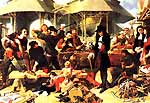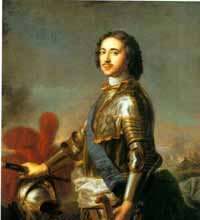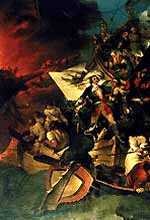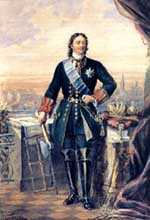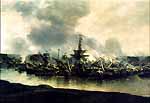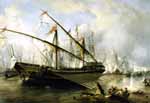| Tell a friend | Print version |
|---|
Peter the First
|
Peter the Great is an outstanding statesman, political and military figure, commander and skilful diplomat; the founder of the Russian Regular Army and Navy. As a child, he got private all-round education at home. Being a man of strong, inflexible will, persistence and high workability, he continued his education throughout his life, acquiring new information and skills in different spheres of knowledge, paying special attention to the military and naval science. In the 80th of the XX Century he organized a so-called “poteshny regiment” (regiment consisted of only boy-soldiers) which later became a prototype of the Russian Army Guards. From1698 to 1693 he studied how to build ships at the Plescheevo Lake. In 1697-1698 he successfully passed a complete course of artillery sciences in Konigsberg, worked as a carpenter on the shipyards of Amsterdam, took a theoretical course of shipbuilding in England.
|
Throughout the time of his reign Peter the Great showed a deep professional understanding of the tasks and challenges that lied ahead of Russia. He introduced key reforms aimed at both overcoming the huge gap that existed between Russia and highly-developed European countries and rational, sustainable use of its vast natural resources.
He assisted in all possible ways to a continuous rise of national economy and country’s production enterprises building as well as its defence potential strengthening. Peter encouraged development of domestic industry and weaving mills; means of communication; domestic and foreign trade, sciences and culture. His hectic, non-stop activity was extremely conducive to the economic, political and cultural growth of Russia, transforming it into the greatest power. While reforming the government structure, Peter provided for the country centralization strengthening.
Under the command of Peter the Great Russia won a triumphant victory in the bloody Northern war of 1700-1721 and gained the access to the Baltic Sea which enabled our country to establish direct relationships with the European countries. The most famous and legendary battle-ground of the Northern war, that went down to history, was a Potlavskaya battle in the year 1709 when the Russian army under the skilful command of Peter the First utterly and completely destroyed the Swedish troops headed by king Charles XII, who, after the unconditional defeat, fled to the Osman Empire together with the ukranian traitor-hetman Mazepa.
Under Peter the Great, the Russian Army and fleet were strictly organized in the most efficient way, i.e., the Army was divided into regiments, brigades and divisions while the Fleet – into squadrons, divisions, subdivisions and detachments; a Unified Dragoon Regiment cavalry was formed. The cornerstone of the Armed Forces organization was the obligatory recruit service and the gentry compulsory military service introduced in 1705. With the purpose of the field army control and management, a rank of Commander-in-chief (Field-Marshal – General) was introduced; its equivalent in the Navy was Admiral-General. A military council (“concilia”) with the field headquarters was established.
|
Peter the Great was the founder of the Russian Naval school, which produced such legendary commanders as P.A. Rumyantsev, A.V. Suvorov, F.F. Ushakov, M.I. Kutuzov. Peter’s strategic planning and far-sighted thoughts passed ahead of time envisaging the further development of his country. His strategy was grand, even aggressive, aimed at crushing defeat or annihilation of the enemies’ armies. He cleverly and skillfully grouped the troops and weaponry at those crucial directions where the defeat of the enemy was expected to be. The victories in battles were gained through concerted actions of all kinds of forces. A defeat of the enemy was followed by a full-scale pursuit. While besieging a fortress, it was considered necessary to launch a swift thrust or attack after conducting a preparatory engineering actions and intensive bombardment (the same technique was used in seizure of Noteburg in 1702 and Narva and Derpt in 1704, etc.). While carrying out military operations during battles, innovative and daring march-maneuvers were conducted. Following Peter’s decree, in order to secure active defense of the Russia’s borders in the beginning of the XVIII Century, extensive construction of coastal fortification lines, fortresses and naval bases (Peter and Paul Fortress, Kronshtadt, Revel, Taganrog, etc) was initiated.
Preserving and multiplying valuable military traditions and unique distinguishing features of the Russian art of war, Peter also took into account the achievements and innovations of the European military science and practices, critically analyzing the possibility of their adjustment to the Russian reality. Being famous for his quick temper, difficult character and strict demand for accurate and immediate fulfillment of his orders, Peter, nevertheless, encouraged initiatives put forward by his subjects. Peter introduced a new tactics of artillery grouping in battles and fortresses seizure; fortification of flanks with a help of grenadier regiments; field redouts arrangement as well as saber attacks of the cavalry and bayonet attacks of the infantry. Peter the First was an author and editor of several statutes and regulations, theoretical and historical works such as “Naval Statute”, “Naval Regulations”, “Admiralty and Shipyard Management Regulations”, “The Book of mars or Military science”, etc.




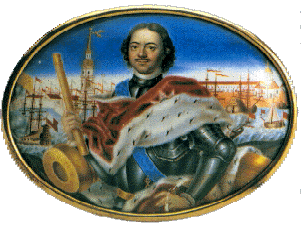 Peter the First
Peter the First